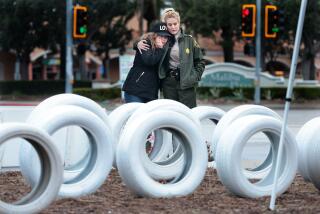Radar’s Deterrent Welcome
Whether merging from one freeway to another or dodging trucks lumbering up hills, motorists need to be more alert than ever, and more mindful of speed.
A year ago, the California Highway Patrol began using radar on Interstate 5 between Glendale and Gorman to clock speeders. Soon after, radar came to a section of that road in southern Orange County. And this month the CHP began using the device on several freeways in central Orange County, roughly from the city of Orange south to Lake Forest.
The more widespread use of the speed-monitoring device is warranted. Motorists may complain when they’re caught with the pedal to the metal, but police say just knowing the radar is around often slows things down.
Motor vehicle accident rates and traffic fatalities have fallen in recent years, an encouraging trend. Increased use of seat belts and the installation of air bags have been contributing factors. But speed remains a threat. Even raising the limit on many freeways to 65 mph has not been enough for some drivers.
Last week four young men and the 17-year-old driver of the car in which they were riding were killed in a crash on the Antelope Valley Freeway, about 15 miles north of Santa Clarita. Police are investigating if the car was in a race with other automobiles in which speeds up to 100 mph were reached.
The tragedy was all too reminiscent of a head-on collision in February on an Orange County toll road. The CHP said the 16-year-old driver of a car traveling at more than 90 mph was killed when it crossed the median and struck another automobile, also killing that car’s two passengers.
The best deterrent to a speeder is the sight of a black-and-white on the freeway. But there is little doubt that the possible presence of radar around the next curve can provide a welcome inhibition as well. CHP officers in the Newhall station say speeding has lessened in the year since they started using radar. In central Orange County, officers began using the device on April 1 and are spending this month warning those they pull over. Come May, the tickets and fines begin.
One area where transportation agencies serving the region need better coordination is reducing the likelihood of truck accidents. The Orange County Transportation Agency, for example, identified interchanges with the most potential for serious truck accidents a year ago. Even so, little has been done to solve problems. One of the interchanges was the site of a fiery crash in Fullerton last month in which the drivers of a tanker truck and a car were killed.
Some progress has been made on the Golden State Freeway near Santa Clarita. Police say many truck-car accidents are the fault of the car drivers, who should be aware that sight lines can be restricted for truck drivers and mirrors are limited in what they show. A combined crackdown on unsafe trucks and education campaign for all drivers last year helped lead to a dramatic drop in truck-related accidents.
All drivers need reminders of what’s safe and what’s not. But dangerous freeway conditions throughout Southern California suggest that many drivers also need the more persuasive presence of police and technology like radar to lessen carnage.
More to Read
Sign up for Essential California
The most important California stories and recommendations in your inbox every morning.
You may occasionally receive promotional content from the Los Angeles Times.










